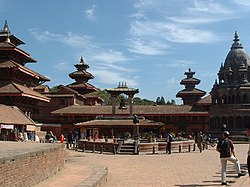Three city-states
Main article: Malla
After the 15th century, the Kathmandu Valley lost its central control and was ruled as three city-states: Kathmandu, Patan, and Bhadgaon. Many Nepalese architectural heritages, such as temples, palaces, including many UNESCO world heritage sites, were built during the rule of the Newar Kings. These include the Kathmandu Old Palace (Kathmandu Durbar Square), Patan Palace (Patan Durbar Square), Bhaktapur Palace (Bhaktapur Durbar Square) etc. By this time, people living in and around Kathmandu Valley (irrespective of their ethnic origins) were called "Newars" (or "Nepa:mi" in "Newari" language meaning, the citizens of Nepal).
Hindu and Buddhist temples in Patan, the capital of one of the three medieval Newar kingdoms
Magar Principalities
Magars are martial people that first established their kingdom in present day western Nepal. They were animistic and shamanic in their religious practices. The Kham Magar of the upper Karnali basin and their brethren of the mid-hills of Nepal had a flourishing and empirical kingdom. Much archaeological proof of their existence can be found in the western mid-hills of Nepal.
The Magar have a strong military and warrior tradition. However, their hospitality and concern for their fellow human beings is also legendary. Two waves of immigrants became the undoing of the Magar empire.
Firstly, the Khasas were welcomed and assimilated within Magar empire. Secondly, due to the advance of Muslim forces into the Gangetic plains of India, the Brahmins entered the Magar empire as refugees.
These two groups were given sanctuary in the Magar empire. The latter group of refugees started to impose their view of Hinduism upon the Magars, while the former group were given the status of Chettri by the latter group in accordance with their view of Hinduism.
This left the Magar people boxed into the third tier in their own kingdom (the first being the Brahmins, the second being the newly elevated Chettri, previously the Khasas).
This meant that the one-time rulers of the Nepali mid-hills became the ruled upon. This was the start of the degradation of the Magar empire. The introduction of Hinduism in itself became the cataclysmic event in the undoing of the Magar empire.
No comments:
Post a Comment